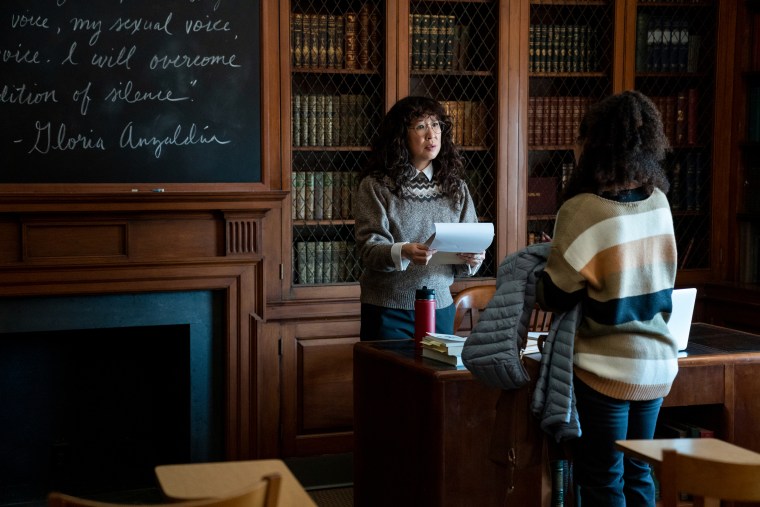As a graduate student studying history, watching “Grey’s Anatomy” and its depiction of surgical trainees made me pine for a TV version of my own professional ambitions. That show has finally now arrived in “The Chair,” starring “Grey’s” alumna Sandra Oh as Ji-Yoon Kim, “an Asian lady who teaches Emily Dickinson,” as she describes herself, who has been promoted to lead the English department at a fictional New England college.
“Gray’s Anatomy” turned the high-stress hospital world into a stylized romance. “The Chair”co-creators Amanda Peet and Annie Wyman skewer academia with dark comedy.
“Gray’s Anatomy” turned the high-stress hospital world into a stylized romance. “The Chair”co-creators Amanda Peet and Annie Wyman skewer academia with dark comedy. But the show’s treatment of crises du jour – from a free speech conflict involving Hitler to the contradictions of Title IX – are too painfully familiar to provide escapist relief. The series’ bleak defeatism is apparent at least halfway through, when Ji-Yoon says with a sigh, “I feel like someone handed me a ticking time-bomb because they wanted to make sure a woman was holding it when it explodes.”
The show offers a window into the opaque world of academia. But its central conflict is misguided. “The Chair” pits diversity in opposition to excellence, a dichotomy that is as common as it is false.
In fact, historically, diversity and excellence have gone hand and hand.
Throughout the history of education, leaders often capitalized on undervalued talent, tapping these “outsiders” to gain a competitive edge for their institutions. In 1876, Daniel Coit Gilman, the founding president of Johns Hopkins University, used its thoroughly modern, non-denominational hiring policy to recruit a celebrated British mathematician who couldn’t get a job at Cambridge or Oxford because he was Jewish.
In 1933, Abraham Flexner offered several positions to German Jews and political refugees fleeing Nazi Germany at his newly founded Institute for Advanced Study, or IAS, in Princeton. Given the discriminatory hiring practices at Harvard, Yale, and Princeton beginning in 1920, its willingness to welcome outsiders gave the fledgling IAS a leg up. Even though he was himself Jewish, Flexner was driven in large part by a desire to gain an advantage in international scientific competition, not humanitarian concerns.
Other outsiders like the female reformer Martha Carey Thomas and the black sociologist W.E.B. Du Bois would have preferred to have been insiders but ultimately used their positions on the periphery to establish parallel institutions, including Bryn Mawr, the first Ph.D-granting women’s college, and the Atlanta Seminars, which raised the profile of Black education. Though they started out on the margins, Jews, women and people of color have played profound roles in the history of American education and its innovations.
The array of caricatures highlights the absence of a leader who understands the value of outsiders to achieve true excellence.
How to make departments and classrooms more inclusive is one of the central themes of “The Chair.” There are only two other women beside Ji-Yoon on the English faculty, an older white woman Joan Hambling (Holland Taylor) who ascended the ranks among the white men, and a rising Black female scholar Yaz McKay (Nana Mensah) who is sought by Yale and to whom Ji-Yoon’s character wishes to give a distinguished lectureship.
The array of caricatures highlights the absence of a leader who understands the value of outsiders to achieve true excellence. Hambling’s character is so concerned with being the only woman of the previous generation that she pulls the ladder up behind her. And Ji-Yoon is unable to show her colleagues how retaining Yaz, and becoming more diverse, might actually improve their department.
From finance to global development, savvy leaders in other fields have recognized that investment in people from overlooked groups can be good strategy. Cherie Blair devised an investment thesis based on the assumption that gender diversity on boards and executive teams improves financial returns. The venture firm Backstage Capital invests in “underestimated founders, including women, people of color, and LGBTQ+ founders,” transforming historical discrimination into an opportunity for arbitrage. And in the international development world of microfinance it has been proven that investing in women is the linchpin not only of individual financial improvement but in raising whole societies out of poverty.
The same could be true in the world of ideas.
Yet in academia, in real life as on TV, the tokenism of the “diversity hire” trivializes the profound impact that women and minorities have had on American education, advancing fields and spurring institutional innovation, and diminishes the connections between diversity and excellence.
The lessons of history are clear: diversity is not just the right thing to do but is in the interest of universities and their standards of excellence. If we are attuned to the opportunity that comes from inviting outsiders in, we will breathe new life into all our institutions.

